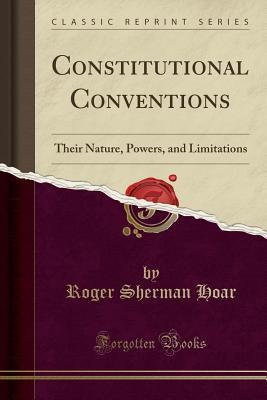Full Download Constitutional Conventions: Their Nature, Powers, and Limitations (Classic Reprint) - Roger Sherman Hoar | ePub
Related searches:
Constitutional Convention and the Delegates Who Attended
Constitutional Conventions: Their Nature, Powers, and Limitations (Classic Reprint)
Constitutions and Constitutional Conventions New York State
State Constitutional Conventions and State Legislative Power - CORE
RG-5. RECORDS OF THE CONSTITUTIONAL CONVENTIONS AND
The U.S. Constitution, Constitutional Conventions, and President
Constitutional conventions, their nature, powers, and
Constitutional Conventions and the Judiciary Oxford Journal
2853 3527 1246 1504 4415 4650 3132 492 3076 818 1946 4775 583 3086 1250 3081 4679 4454 887 3971 1275 1636 3143 2585 3831 4346 524 4310 160 2645 222 3116 4684 705 4284 3243 491 3719 3609
Constitutional conventions, their nature, powers, and limitations by hoar, roger sherman, 1887-publication date 1917 topics constitutional conventions publisher.
The constitutional convention was called in may of 1787 to make revisions to the articles of confederation. George washington was immediately named the convention's president. The articles had been shown since their adoption to be very weak.
Practices relating to the exercise of their functions by the crown, the government, parliament, and the judiciary that are not legally enforceable but are commonly.
The difference between a convention and a law is that laws are enforced by courts, with legal sanctions following their breach, whilst conventions are enforced.
Some proponents of a convention express doubt that an article v convention would exceed its scope, in light of the united states' experience with state constitutional conventions; over 600 state constitutional conventions have been held to amend state constitutions, with little evidence that any of them have exceeded their scope.
The constitutional convention (contemporarily known as the federal convention, the philadelphia convention, or the grand convention at philadelphia) took place from may 25 to september 17, 1787, in the old pennsylvania state house (now known as independence hall) in philadelphia.
On may 25, seven of the states met their internal quorum requirement and so a majority (seven) of the thirteen states were represented at the constitutional.
In drafting state constitutions prior to the ratification of the national constitution, new york and its fellow original states established a tradition of dual.
In february 1787, congress decided that a convention should be convened to revise the articles of confederation, the nation's first constitution.
The constitution did not include explicit protection of first amendment rights.
The remarkable achievement of the fifty-five men gathered in philadelphia during the summer of 1787 was by no means inevitable. Looking back on their work that summer, we can identify a few factors that enabled them to achieve their success.
The constitutional convention of 1821 resulted in the first submission of a new constitution for approval by the state's electorate. Approved by a wide margin, the new constitution included a bill of rights and removed property qualifications for white male voters, yet expanded property qualifications for african americans.
The meeting of the constitutional convention began on may 25, 1787. Delegates met on 89 of the 116 days between may 25 and their final meeting on september 17, 1787. The meetings took place at independence hall in philadelphia, pennsylvania. Twelve of the 13 original states participated by sending delegates to the constitutional convention.
In 1787, the framers of the us constitution came together to create a stronger central government.
Debates in constitutional conventions in the united states in 1787 and australia in 1897 reveal similarities and differences that illuminate the process by which.
A treatise on constitutional conventions: their history, powers, and modes of proceeding item preview.
Constitutional convention begins four years after the united states won its independence from england, 55 state delegates, including george washington, james madison and benjamin franklin, convene.
History, convention that drew up the constitution of the united states. Stimulated by severe economic troubles, which produced radical political movements such as shays’s rebellion, and urged on by a demand for a stronger central government, the convention met in the pennsylvania state house in philadelphia (may 25–september 17, 1787), ostensibly to amend the articles of confederation.
When the 55 delegates gathered in philadelphia to revise the articles of confederation, there were several major 5 issues at the constitutional convention.
The convention was the site of spirited debate over the size, scope, and structure of the federal government, and its result was the united states constitution. The notorious three-fifths compromise apportioned representation to the southern slaveholding states in a scheme that counted five enslaved men and women as three.
Mar 1, 2017 constitutional conventions can be thought of as norms, principles, precepts, and maxims that guide government officials in the exercise of their.
Aug 10, 2006 constitutional conventions are a distinctly american political innovation, first appearing during the era of the revolutionary war (1775-83).
“constitutional convention is like a medicine which can cure even that disease which cannot be cured by the doctor”, in simple words it is the convention which can cure all difficult situation where there is no law to govern such situations”. The study of the constitutional convention is always anchored with an assumption that has been so far remained unchallenged.

Post Your Comments: